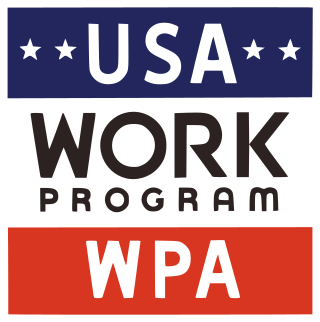
The Works Progress Administration was an American New Deal agency that employed millions of jobseekers to carry out public works projects, including the construction of public buildings and roads. It was set up on May 6, 1935, by presidential order, as a key part of the Second New Deal.
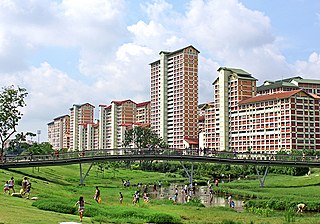
Public housing is a form of housing tenure in which the property is usually owned by a government authority, either central or local. Although the common goal of public housing is to provide affordable housing, the details, terminology, definitions of poverty, and other criteria for allocation vary within different contexts. Within the OECD, social housing represents an average of 7% of national housing stock (2020), ranging from ~34% in the Netherlands to less than 1% in Colombia.

The United States Department of State Bureau of Overseas Buildings Operations (OBO) is responsible for overseeing the construction, management, and operations of U.S. diplomatic facilities around the world.
Inclusionary zoning (IZ) is municipal and county planning ordinances that require or provide incentives when a given percentage of units in a new housing development be affordable by people with low to moderate incomes. Such housing is known as inclusionary housing. The term inclusionary zoning indicates that these ordinances seek to counter exclusionary zoning practices, which exclude low-cost housing from a municipality through the zoning code. Non-profit affordable housing developers build 100% of their units as affordable, but need significant taxpayer subsidies for this model to work. Inclusionary zoning allows municipalities to have new affordable housing constructed without taxpayer subsidies. In order to encourage for-profit developers to build projects that include affordable units, cities often allow developers to build more total units than their zoning laws currently allow so that there will be enough profit generating market-rate units to offset the losses from the below market-rate units and still allow the project to be financially feasible. Inclusionary zoning can be mandatory or voluntary, though the great majority of units have been built as a result of mandatory programmes. There are variations among the set-aside requirements, affordability levels, and length of time the unit is deed-restricted as affordable housing.

Tax increment financing (TIF) is a public financing method that is used as a subsidy for redevelopment, infrastructure, and other community-improvement projects in many countries, including the United States. The original intent of a TIF program is to stimulate private investment in a blighted area that has been designated to be in need of economic revitalization. Similar or related value capture strategies are used around the world.

Public housing in Hong Kong is a set of mass housing programmes through which the Government of Hong Kong provides affordable housing for lower-income residents. It is a major component of housing in Hong Kong, with nearly half of the population now residing in some form of public housing. The public housing policy dates to 1954, after a fire in Shek Kip Mei destroyed thousands of shanty homes and prompted the government to begin constructing homes for the poor.
The San Francisco Arts Commission (SFAC) is the City agency that champions the arts as essential to daily life by investing in a vibrant arts community, enlivening the urban environment and shaping innovative cultural policy in San Francisco, California. The commission oversees Civic Design Review, Community Investments, Public Art, SFAC Galleries, The Civic Art Collection, and the Art Vendor Program.

The Delhi Development Authority (DDA) is a statutory body established under the Delhi Development Act, 1957, under the jurisdiction of the Ministry of Housing and Urban Affairs, Government of India to "promote and secure the development of Delhi". It is responsible for planning, development and construction of housing projects, commercial lands, land management as well as providing public facilities like roads, bridges, drains, underground water reservoirs, community centres, sports centres, green belts etc. within the area of National Capital Territory of Delhi, India.
Members of Parliament Local Area Development Scheme (MPLADS) is a scheme formulated by Government of India on 23 December 1993 that enables the members of parliaments (MP) to recommend developmental work in their constituencies with an emphasis on creating durable community assets based on locally felt needs.
Drinking water supply and sanitation in Pakistan is characterized by some achievements and many challenges. In 2020, 68% Pakistanis, 72% Indians, 54% Bangladeshi had access to the basic sanitation facilities. Despite high population growth the country has increased the share of the population with access to an improved water source from 85% in 1990 to 92% in 2010, although this does not necessarily mean that the water from these sources is safe to drink. The share with access to improved sanitation increased from 27% to 38% during the same period, according to the Joint Monitoring Program for Water Supply and Sanitation. There has also been considerable innovation at the grass-root level, in particular concerning sanitation. The Orangi Pilot Project in Karachi and community-led total sanitation in rural areas are two examples of such innovation.

In the United States, subsidized housing is administered by federal, state and local agencies to provide subsidized rental assistance for low-income households. Public housing is priced much below the market rate, allowing people to live in more convenient locations rather than move away from the city in search of lower rents. In most federally-funded rental assistance programs, the tenants' monthly rent is set at 30% of their household income. Now increasingly provided in a variety of settings and formats, originally public housing in the U.S. consisted primarily of one or more concentrated blocks of low-rise and/or high-rise apartment buildings. These complexes are operated by state and local housing authorities which are authorized and funded by the United States Department of Housing and Urban Development (HUD). In 2020, there were one million public housing units. In 2022, about 5.2 million American households that received some form of federal rental assistance.
Metropolitan Area Projects Plan (MAPS) is a multi-year, municipal capital improvement program, consisting of a number of projects, originally conceived in the 1990s in Oklahoma City by its then mayor Ron Norick. A MAPS program features several interrelated and defined capital projects, funded by a temporary sales tax, administered by a separate dedicated city staff funded by the sales tax, and supervised by a volunteer citizens oversight committee.
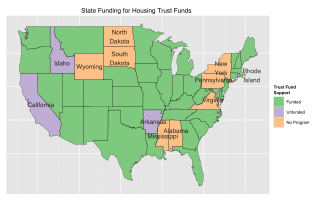
Housing trust funds are established sources of funding for affordable housing construction and other related purposes created by governments in the United States (U.S.). Housing Trust Funds (HTF) began as a way of funding affordable housing in the late 1970s. Since then, elected government officials from all levels of government in the U.S. have established housing trust funds to support the construction, acquisition, and preservation of affordable housing and related services to meet the housing needs of low-income households. Ideally, HTFs are funded through dedicated revenues like real estate transfer taxes or document recording fees to ensure a steady stream of funding rather than being dependent on regular budget processes. As of 2016, 400 state, local and county trust funds existed across the U.S.
Examples of health care systems of the world, sorted by continent, are as follows.
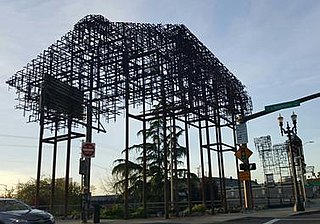
Inversion: Plus Minus is a pair of outdoor sculptures designed by artists and architects Annie Han and Daniel Mihalyo, located in southeast Portland, Oregon. The sculptures, constructed from weathered steel angle iron, are sited near the Morrison Bridge and Hawthorne Bridge along Southeast Grand Avenue and represent "ghosts" of former buildings. The installation on Belmont Street emphasizes "negative space" while the sculpture on Hawthorne Street appears as a more solid matrix of metal. According to the artists, the works are reminiscent of industrial buildings that existed on the project sites historically. Inversion was funded by the two percent for art ordinance as part of the expansion of the Eastside Portland Streetcar line and is managed by the Regional Arts & Culture Council.
A reduced fare program refers to special programs providing particular passengers with a discounted fare option for travel on a public transport system. In the United States, public transportation systems that receive federal funding are required to offer, at minimum, half fares to the elderly and handicapped persons during off peak travel. Some transportation systems also extend reduced fare options to youth, students, military personnel, and low-income passengers.
Public plans for energy efficient refurbishment are put in place by states to encourage building owners to renovate their properties in a way that increases their energy performance. As financing represents the most important obstacle to this type of renovation, the plans favour financial incentives in the form of loans or grants. Various institutions can be involved in the process, such as ministries, banks, firms, or energy services companies (ESCOs).
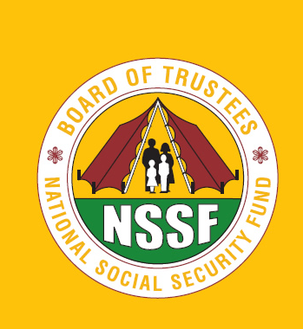
The National Social Security Fund (NSSF) is the government agency of Tanzania responsible for the collection, safekeeping, responsible investment, and distribution of retirement funds of all employees in all sectors of the Tanzania economy that do not fall under the governmental pension schemes. The headquartersare located in Kivukoni ward of Ilala District of Dar es Salaam Region. There are one other pension fund organizations in the country; the Public Services Social Security(PSSSF). Fund for all employees working directly under the government and for all employees working under governmental Parastatal organization

Affordable housing is housing that is deemed affordable to those with a median household income as rated by the national government or a local government by a recognized housing affordability index. A general rule is no more than 30% of gross monthly income should be spent on housing, to be considered affordable as the challenges of promoting affordable housing varies by location.

amaptocare is a large-scale public art work, in the form of a participative sponsored tree-planting project in Ballymun on the Northside of Dublin, Ireland. Proposed by German conceptual artist Jochen Gerz and commissioned by Breaking Ground on behalf of Dublin City Council's Ballymun Regeneration Limited as a percent for art scheme, it involved planting semi-mature trees in each neighbourhood of Ballymun, each with a personal comment from its sponsor inscribed on a nearby metal lectern. Over 630 trees from a choice of 15 mostly native varieties were sponsored, most by locals and other Dubliners, and 620 were planted by 2006.











